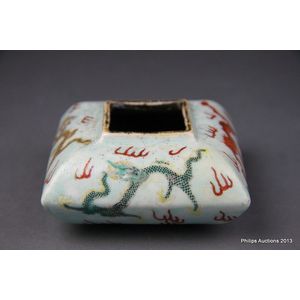Fencai Enamel Seal Box with Scholar and Landscapes
You must be a subscriber, and be logged in to view price and dealer details.
Subscribe Now to view actual auction price for this item
When you subscribe, you have the option of setting the currency in which to display prices to $Au, $US, $NZ or Stg.
- Bevel / Chamfer - In furniture making, a chamfered corner refers to a technique used to create a smooth, angled edge on the corner of a piece of furniture. This is typically done by cutting away a small portion of the corner at an angle, typically 45 degrees, creating a diagonal edge, rather than a sharp 90-degree angle. This technique can be used on various parts of a piece of furniture such as table legs, drawer fronts, or door frames. Chamfering can add visual interest to a piece and can help to soften the overall look of a piece of furniture. It is often used in conjunction with other techniques, such as rounding edges or using contrasting wood species to create a more elegant, sophisticated look. Chamfering is a simple way to add a touch of elegance to a piece of furniture and it is a common technique used by furniture makers.
- Qing Dynasty - The Qing Dynasty was the last imperial dynasty of China, ruling from 1644 to 1912. It was established by the Manchu people, who originated from the northeastern region of China. The Qing Dynasty was preceded by the Ming Dynasty and followed by the Republic of China.
- Ming Dynasty - The Ming Dynasty was a ruling dynasty of China from 1368 to 1644. It succeeded the Yuan Dynasty and preceded the Qing Dynasty. The Ming Dynasty was established by Zhu Yuanzhang, a former Buddhist monk who became a rebel leader and eventually overthrew the Mongol Yuan Dynasty. During the Ming Dynasty, China experienced a period of relative stability and prosperity. The government was centralized and bureaucratic, with the emperor at the top of the hierarchy. The Ming Dynasty is known for its cultural achievements, including the development of porcelain, the invention of movable type printing, and the construction of the Great Wall of China.
This item has been included into following indexes:
- oriental objects - boxes 1,852
Visually similar items

Cinnabar lacquer lidded box, 5 cm high, 15 cm wide, 10 cm deep

A Chinese brown aventurine-glass powder box with hardstone inlay, incised four-character Qianlong mark but later the box of lobed form raised on short foot rim, the top slightly raised, inlaid with green and red hard stones and mother of pearl with flowers

Japanese Imari rectangular dish decorated with central underglaze blue floral motif, surrounded by reserves of flowers and trees, length 19 cm

A Chinese porcelain brush pot, apparently mid Qing Dynasty (1723-1735), of square cushion form with all four sides decorated with finely painted contesting dragons upon a delicately incised pale turquoise ground; with Yongzheng marks underside. Height 3.5
